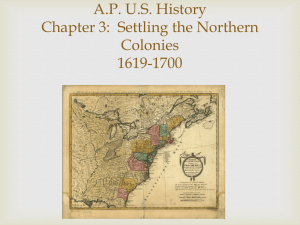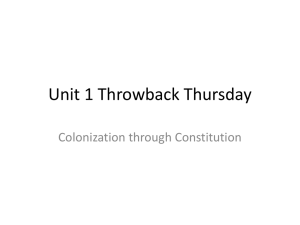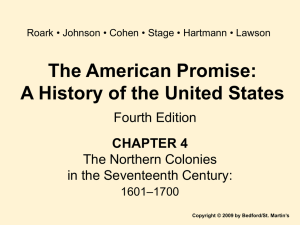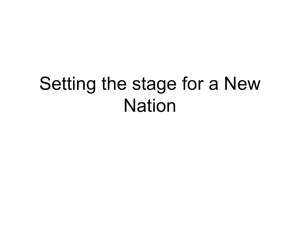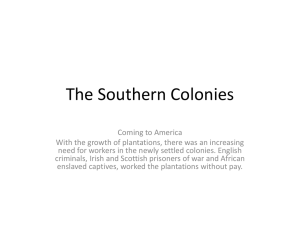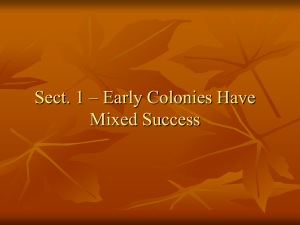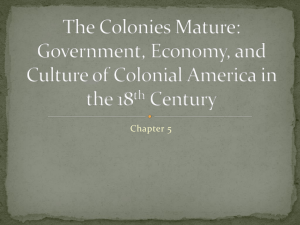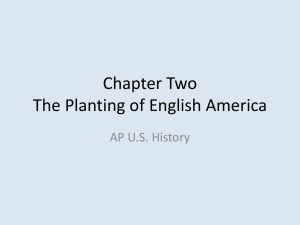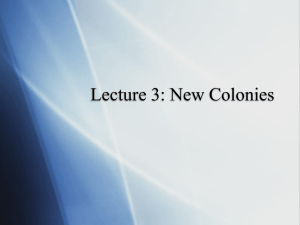Unit 1
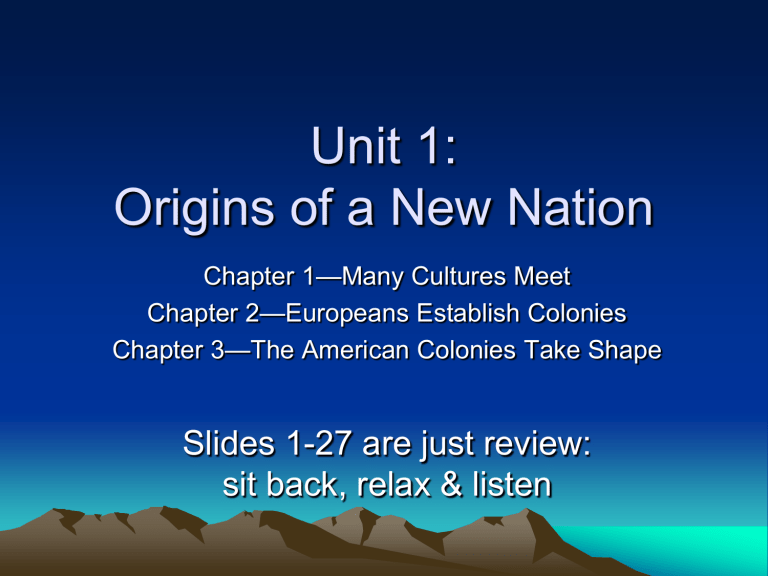
Unit 1:
Origins of a New Nation
Chapter 1 —Many Cultures Meet
Chapter 2 —Europeans Establish Colonies
Chapter 3 —The American Colonies Take Shape
Slides 1-27 are just review: sit back, relax & listen
Arrival of the first Americans
• 10,000-40,000 years ago.
• Crossed land bring connecting Siberia and Alaska.
– Where is it now?
– Why this bridge?
• Spread in N & S Amer
• 3 most advanced civilizations in Central and South America.
– Inca
• Peru and Ecuador
– Mayan
• Southern coach of Gulf of Mexico
– Aztec
• Mexico
The American Indians
The First People of the Americas
Main Idea: Scholars believe Paleoindians, or the first humans to live in the Americas, came from Siberia and eventually developed permanent villages where they practiced farming.
Early American Indian Cultures
Main Idea: Many Native American cultures emerged in the Americas centuries before the arrival of Columbus. Distinct cultures developed in areas such as the Southwest, the Mississippi River Valley, the Great
Plains, and the Eastern Woodlands.
Common Cultural Features
Main Idea: Although there was great cultural diversity among early
Native Americans, they did share some cultural traits. These included de-centralized political power, spiritual beliefs, shared property and land, and gender roles.
The Vikings
• You mean Europeans weren’t the first?!
• Came from Norway
– 800-1000 AD
• Eric the Red, Leif
Ericson
– True Blood anyone?
• Why no credit?
– No claims, little evidence.
The Europeans
Life in Europe in the 1400s
Main Idea: At the start of the fifteenth century, in the wake of the bubonic plague, Europe had several key characteristics. The economy became centered on agriculture, only a small minority of the population possessed wealth and power, and various kingdoms waged war with one another.
Europe Looks Beyond Its Borders
Main Idea: Rapidly expanding trade and the religious wars known as the
Crusades exposed Europeans to different parts of the world. A new era, known as the Renaissance, began.
The Portuguese Begin to Explore
Main Idea: Due to its geographic location and technological developments, the
Portuguese took the lead in exploring new trade routes and areas for expansion of power.
Continued…
QUICK STUDY
Renaissance Changes Europe
Explorers and Colonies
• Why go to America?
– Renaissance
– Religious conflict
– Expanding trade (Marco Polo)
– The 3 G’s!!!
• Gold
– A desire for wealth…New job opportunities, precious metals, etc.
• God
– Duty to spread one’s religion
• Glory
– Be there first! See the new stuff first!!!!
Follow the Leader
• First.. Spain &
Portugal.
• Then… France &
Holland.
• Finally… Great
Britain.
Why did they come?
• Portugal: water routes to India & Asia
– Claimed colonies, ie: Brazil
• Spain: water routes, conquistadors
– Land, wealth, slaves
– Colonies = sugar
– Indian then African slaves
• FR: water routes, colonization
– Fur trade around
Great Lakes
– Known as “coureurs de bois”
– Friendly with Indians
• Britain - Upper hand in
North American and set the stage for….. US!
Who came?
Portugal
• Prince Henry the Navigator
– Est. Nautical school
– Water route to Asia
• Made it to West Africa
• Vasco de Gama
– Sailed around Southern tip of Africa to India
• Amerigo Vespucci
– Italian; mapped coast of S. America.
• Work used to map the “New World”
Who came?
Spain
• Christopher Columbus
– Italian; sent by Ferdinand & Isabella to Asia (didn’t quite make it)
• 3 ships, 90 sailors, landed San Salvador
10/12/1492
• Balboa
– Sailed to Panama; 1 st European to see Pacific
Who came?
Spain
• Ferdinand Magellan
– Sailed around S. Amer tip (straight of
Magellan)
– Called Pacific
“peaceful waters”
– Sailed around the world
• Hernando Cortes
– Conquistador
– Sailed to Mexico with
Army
– Destroyed Aztecs, claimed
Mexico
TRANSPARENCY
Magellan’s Voyage
Hernan Cortes & Francisco Pizzaro
• Hernan Cortes
– Sent by Cuba to conquer the Aztec’s in Mexico.
– Aztec capital, Tenochtitlan (present day Mexico city) had
400,000 people there.
– Aztec’s governed about 20 million people (twice the size of
Spain’s) and Cortes could only gather 600 soldiers.
– Cortes learned that the Aztecs conquered many Native
Americans and were able to enlist the help of 200,000 Mexicans.
– By 1521, Cortes had conquered one of the largest empires in the world.
• Francisco Pizzaro
– Conquered the Inca (what is now Peru)
Control of the Spanish Empire
• These new lands and people became…
– Colonies: areas settled by immigrants who continue to be ruled by their parent country.
• The Spanish became soooo rich!
– Had enslaved Native Americans and Africans, mined silver and gold in Peru, established farms and ranches, etc.
• Didn’t make Indians leave…forced them to become part of Spanish culture.
– Because they all lived together…a new race emerged
• Mestizo : Mix of Spanish and Native American.
• "With my own eyes I saw Spaniards cut off the nose, hands and ears of Indians, male and female, without provocation, merely because it pleased them to do it. ... Likewise, I saw how they summoned the caciques and the chief rulers to come, assuring them safety, and when they peacefully came, they were taken captive and burned."
"[The Spaniards] took babies from their mothers' breasts, grabbing them by the feet and smashing their heads againt rocks. ...They built a long gibbet, low enough for the toes to touch the ground and prevent strangling, and hanged thirteen [natives] at a time in honor of Christ Our
Saviour and the twelve Apostles. ...Then, straw was wrapped around their torn bodies and they were burned alive."
Who came?
Spain
• Ponce de Leon
– Sought the fountain of youth
– Claimed Florida
• Land of Flowers
• Spanish Empire caused inflation to rise in
Europe
– San Salvador, Mexico, Florida, etc.
Who came?
• Jacques Cartier
France
– Looking for Northwest Passage, explored St. Lawrence River
• Samuel de Champlain
– Founded colony of Quebec in 1608
• Robert LaSalle
– Followed Mississippi River, claimed it
– Named Louisiana after King Louis XIV
• Great location!
Who came?
Britain
• Sir Francis Drake
– “Sea Dog”, sent by
Queen Elizabeth I
• Mission: pillage
Spanish America and ships
– Defeated Spanish
Armada
• Huuuge fleet 130 ships
& 27,000 sailors
– Ensured GB’s naval dominance in North
Atlantic
Others…
• Henry Hudson
– British but sailed for Dutch
– Explored NY Harbor & settled New
Amsterdam (later NY)
• Had patroonships – feudal estates
The West Africans
West African Kingdoms
Main Idea: Various kingdoms, such as Ghana, Mali, and Songhai flourished in West Africa. With the arrival of Portuguese explorers in the
1400s, the kingdoms became important trade centers.
West African Life
Main Idea: West African civilizations were diverse and well developed.
Religious beliefs varied but contributed to strong communal ties, as did family bonds.
Slavery in Africa
Main Idea: Slavery was common in West Africa. West African rulers commonly sold conquered or captured people as slaves to traders, including Arabs and the Portuguese.
Now let’s talk about:
The
British
Colonies
Notes sStart
Here!
Activity Check
• Royal colony
– Belonged to the crown
• Proprietary colony
– Belonged to powerful individuals or companies
• Joint-stock colony
– Business venture founded and run by a group of investors who were to share in the company’s profits and losses
• New England colonies
– New Hampshire,
Massachusetts, Connecticut,
Rhode Island
• Middle colonies
– New York, New Jersey,
Pennsylvania, Delaware
• Southern colonies
– North Carolina, South
Carolina, Georgia, Virginia,
Maryland
Jamestown:
England’s first permanent colony
• Est. by the VA Comp.
– Chesapeake Bay area
• Fertile land, good harbors and rivers
• 144 settlers came and settled on James
River
• No women
• Only 4 carpenters
Hardships for Jamestown
• Diseases (Malaria)
• Not used to hard work
• Starvation
– Dependent on supplies from GB and Natives
• 1 st year – only 38 survivors
• 800 more came – only 60 survived “starving time” of winter 1609.
– Ate rats, mice…. Even resorted to cannibalism
Governing Jamestown
• John Smith
– Forceful leader
• John Rolfe
– Est. tobacco industry
• Slavery introduced
• Pocahontas
– Rolfe’s wife
– Helped with Indian relations
- Daughter of Powhatan
Jamestown in peril
• Tobacco – successfully cultivated
– Slavery introduced, but…
• VA Co. goes into debt
– Charter is revoked
– VA becomes first
Royal Colony
• Appointed a Governor –
Sir William Berkeley
• Berkeley
– Taxed poor planters more than wealthy people
• Burned to ground b/c
Bacon’s Rebellion
• Settlers wanted to take land from Indians
– Berkeley didn’t help, so….
Bacon’s Rebellion
• In 1676, Nathaniel Bacon raised an army to fight the
Indians & Berkeley.
• Berkeley defeated and
Jamestown burned.
• 1 month later, Bacon died.
– New Gov. appointed
Importance of Bacon’s Rebellion
• 1.) Sharp class differences between wealthy planters and landless/poor farmers
• 2.) Colonial resistance to royal control
• 3.) More frontier access = more conflicts with Indians.
The Roanoke Disaster
• Walter Raleigh tried twice to start a colony on Roanoke Island (1580’s).
– Along coast of North Carolina
• 1 st attempt – settlers facing starvation returned home
• 2 nd attempt – settlers disappeared
• Were they defeated by the Indians…did they join them…no one knows.
Plymouth Colony (Mass Bay)
• Joint Stock
• Jamestown est. for economic reasons,
Plymouth est. by religious separatists
• AKA: PURITANS
• The PILGRIMS, came on the ….
– MAYFLOWER (1620)
• Signed: Mayflower Compact
– First written governing doc. of our nation!
• Laws made by majority; all would obey
Plymouth Colony, cont.
• ½ settlers died by Spring
– Squanto & corn
– Deep faith and determination helped them survive…
• THANKSGIVING!
• Leader:
– William Bradford
• Became part of Mass.
Bay Colony.
Massachusetts Bay Colony
• Started as joint stock, 1630
• Many came b/c of GREAT MIGRATION
• Home to many Puritans, “City on a Hill”
– Wanted to purify Church of England
• Under Calvinist leaders, became a theocracy (what’s that)?
– Church is paramount in all decisions, political and religious.
Mass Bay, cont.
• Ironic - Religious intolerance
– Banished if don’t agree
• Dissident founded many other colonies
• First English Colony to est. basis of representative gov’t
– No ______ without ______!
Connecticut
Other colonies:
• Joint stock
• Founder: Thomas
Hooker
• Religion less imp.
Than commerce
• First to write a
Constitution
New Hamp & Maine .
• New Hampshire &
Maine:
• 2 Englishmen given a gov’t grant to areas north of
Mass., divided land
• New Hampshire
– Founder: John
Wheelwright (expelled)
– Joint stock, then royal
• Maine – part of Mass
Bay Colony until 1820.
Other Colonies:
Rhode Island
• Joint Stock
• Founder: Roger
Williams
– Banished from Mass b/c wanted sep. of church & state
• Est. Providence (later
RI)
• Bought land from
Indians!
• Was unique:
– Recognized rights of N.
Americans and paid them for land
– Complete religious toleration all allowed to come and worship
• Religious refugees came
– 1663, Parliament granted free religion charter
Halfway Covenant
• Mid 17 th cent, a generation has gone by since first Puritans came to NE.
• New generation seemed less committed to religion & more interested in $$$.
• Halfway Covenant offered by some clergymen to those who professed limited religious commitment.
– People could now participate without declaration their total belief in JC.
New England Confederation
• Plymouth, Mass Bay,
Connecticut & New
Haven
– Formed a military alliance from threat of
Natives.
• Lasted until 1684
– Crown ended it.
• Est. a precedent to take unified action against Natives.
King Phillip’s War
• Metacom (King Philip, in Eng.) leader of the Algonquin people.
– United many tribes in Southern New
England against English settlers.
• Vicious War (1675-76)
– Thousands killed on both sides
– Dozens towns/villages burned
• English struck back.
– Metacom was caught and killed
– Head placed on display in Boston.
• Significance:
– Virtually ended Indian resistance in New England.
The Middle and Southern Colonies
• Included: New
York, New
Jersey,
Pennsylvania, and Delaware.
• In middle of the
Atlantic coast of
North America.
• New York was very diverse
Middle Colonies
The Middle Colonies:
New York
• Est. by Dutch Joint Stock
– Then GB Proprietary, became English colony through conquest
• England & Holland in war over N.Amer fur trade
• Duke of York given a fleet by brother King
Charles II to capture New Amsterdam
– Did in 1664; named for him after capture
• Ethnically diverse area
Middle Colonies:
New Jersey & Delaware
• New Jersey
– Also Dutch Joint Stock then GB proprietary
• Originally owned by Duke York too, gave it to other rich guys
• Delaware
– Proprietary
– Started by Swedes, taken by Dutch, then taken by
English.
– Also owned by Duke of York, later purchased by
William Penn
• Scared Penn was land-locked
Middle Colonies:
Pennsylvania
• Proprietary – William
Penn given grant for settlement
• Founded as sanctuary for Quakers
– Passive resistance
– Non-paid clergy
– Equality for women
– Simple meeting houses
• Very democratic:
– No military service
– Anti-slavery
– No paid clergy
– No swearing oaths to King
• Most successful and diverse of all 13 colonies:
– Philly – “City of Brotherly
Love”
• Virginia, Maryland,
• Maryland (Proprietary)
– Refuge for Catholics by
Lord Baltimore
– Bicameral legislature est.
– Religious probs b/t Cath and Christians
– 1649: Maryland Toleration
Acts
• Freedom of worship for
Christians
• Carolina’s
(Proprietary)
Southern Colonies:
Carolina’s
– Land reward for those who restored monarchy after
English Civil War
– Religious and political freedom… but – slavery?
• Tobacco – Tarheels
• Not indentured servitude
• Proprietors had investments in slave trade
– 1729 – Split in two
• SC thought better than
NC
– Better harbors; grew sugar, rice & indigo
Southern Colonies:
Georgia
• Proprietary
– Started as a Penal colony by James Ogelthorpe
• Rum, Catholics and Slaves – prohibited!
– In the beginning…
• Originally a haven for those who had been jailed in England b/c they couldn’t pay their debts.
